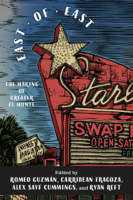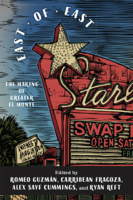Aloha Compadre
Latinxs in Hawai'i
Aloha Compadre is the first study to examine the collective history and contemporary experiences of the Latinx population of Hawaiʻi. It reveals that contrary to popular discourse, Latinx migration to Hawaiʻi is not a recent event. From the early 1830s to the present, Latinx communities have been a part of the cultural landscape of Hawaiʻi prior to annexation, territorial status, and statehood.
Indigeneity in Real Time
The Digital Making of Oaxacalifornia
By launching cutting-edge Internet radio stations and multimedia platforms and engaging as influencers, Zapotec and Ayuujk peoples paved their own paths to a transnational lifeway between Mexico and the United States during the Trump era. Their novel digital formats put into practice political visions concerning Indigenous communality across vast distances—in real time.
Elena, Princesa of the Periphery
Disney’s Flexible Latina Girl
Princesa of the Periphery explores Disney’s Elena of Avalor. Focusing on girlhood and Latinidad, Leon-Boys studies the complex relationship between the U.S.’s largest ethnic minority and Disney as a global media conglomerate. The analysis demonstrates that Elena’s existence within the Disney universe is indicative of the overall presence of Latinxs in popular culture, media, and the nation.
The "Puerto Rican Problem" in Postwar New York City
Day of the Dead in the USA, Second Edition
The Migration and Transformation of a Cultural Phenomenon
Embodied Economies
Diaspora and Transcultural Capital in Latinx Caribbean Fiction and Theater
Latinas on the Line
Invisible Information Workers in Telecommunications
Precarity and Belonging
Labor, Migration, and Noncitizenship
Approaching mobility, precarity, and citizenship at once generates a critical exploration of the points of contact and friction and the potential politics of commonality between citizens and noncitizens. What does modern citizenship mean in a world of citizens, denizens, and noncitizens living under common conditions of labor and social precarity? Precarity and Belonging interrogates such binaries as citizen/noncitizen, and “legal”/“illegal” to explore the fluidity of the spectra of belonging.
Precarity and Belonging
Labor, Migration, and Noncitizenship
Approaching mobility, precarity, and citizenship at once generates a critical exploration of the points of contact and friction and the potential politics of commonality between citizens and noncitizens. What does modern citizenship mean in a world of citizens, denizens, and noncitizens living under common conditions of labor and social precarity? Precarity and Belonging interrogates such binaries as citizen/noncitizen, and “legal”/“illegal” to explore the fluidity of the spectra of belonging.
Deportes
The Making of a Sporting Mexican Diaspora
East of East
The Making of Greater El Monte
East of East
The Making of Greater El Monte
Becoming Transnational Youth Workers
Independent Mexican Teenage Migrants and Pathways of Survival and Social Mobility
Parcels
Memories of Salvadoran Migration
Forging Arizona
A History of the Peralta Land Grant and Racial Identity in the West
Constituting Central American–Americans
Transnational Identities and the Politics of Dislocation
Post-Borderlandia
Chicana Literature and Gender Variant Critique
LatinAsian Cartographies
History, Writing, and the National Imaginary
In Search of the Mexican Beverly Hills
Latino Suburbanization in Postwar Los Angeles
From the Edge
Chicana/o Border Literature and the Politics of Print
Southwest Asia
The Transpacific Geographies of Chicana/o Literature
Of Forests and Fields
Mexican Labor in the Pacific Northwest
Mexico on Main Street
Transnational Film Culture in Los Angeles before World War II
Family Activism
Immigrant Struggles and the Politics of Noncitizenship
Family Activism
Immigrant Struggles and the Politics of Noncitizenship
The Virgin of Guadalupe and the Conversos
Uncovering Hidden Influences from Spain to Mexico
Mexican Hometown Associations in Chicagoacán
From Local to Transnational Civic Engagement
Salvadoran Imaginaries
Mediated Identities and Cultures of Consumption
Salvadoran Imaginaries
Mediated Identities and Cultures of Consumption
Dream Nation
Puerto Rican Culture and the Fictions of Independence
Borderlands Saints
Secular Sanctity in Chicano/a and Mexican Culture
Borderlands Saints examines the rise and fall of popular saints and saint-like figures in the borderlands of the United States and Mexico. Focusing specifically on Teresa Urrea (La Santa de Cabora), Pancho Villa, César Chávez, Subcomandante Marcos, and Santa Muerte, the book traces the intersections of these figures, their devotees, artistic representations, and dominant institutions with an eye for the ways in which such unofficial saints mirror traditional spiritual practices and serve specific cultural needs.
Hidden Chicano Cinema
Film Dramas in the Borderlands
This visual representation of New Mexico and its people is a fascinating study of how the region has been depicted in film from the dawn of early filmmaking and the silent era to today. Meléndez examines such films as Adventures in Kit Carson Land, The Rattlesnake, and Red Sky at Morning, among others, that have both educated and misinformed us about a state in our own midst that remains a “distant locale” to most white Americans.
Domestic Negotiations
Gender, Nation, and Self-Fashioning in US Mexicana and Chicana Literature and Art
Domestic Negotiations explores how U.S. Mexicana and Chicana authors and artists across different historical periods and regions use domestic space to actively claim their own histories. Drawing from a range of archival sources and cultural productions, the book demonstrates how the very sites of domesticity are used to engage with the many political and recurring debates about race, gender, and immigration affecting the lives of Mexicanas and Chicanas from the early twentieth century to today.
Troubling Nationhood in U.S. Latina Literature
Explorations of Place and Belonging
This book examines the ways that recent U.S. Latina literature challenges popular definitions of nationhood and national identity. It explores the works of Mexican American, Puerto Rican, and Cuban American writers Denise Chavez, Ana Castillo, Sandra Cisneros, Judith Ortiz Cofer, Esmeralda Santiago, and Himilce Novas to show how these texts argue for the legitimate belonging of Latino/as within U.S. borders and counter much of today’s anti-immigration rhetoric.
Zapotecs on the Move
Cultural, Social, and Political Processes in Transnational Perspective
Through interviews with three generations of Yalálag Zapotecs (“Yalaltecos”) in Los Angeles and Yalálag, Oaxaca, Adriana Cruz-Manjarrez examines the impact of international migration on this community, tracing five decades of migration to Los Angeles to delineate migration patterns, community formation in Los Angeles, and the emergence of transnational identities of the first and second generations of Yalálag Zapotecs in the U.S.
Disenchanting Citizenship
Mexican Migrants and the Boundaries of Belonging
Luis F. B. Plascencia’s Disenchanting Citizenship explores two interrelated issues: U.S. citizenship and the Mexican migrants’ position in the United States. Through an extensive and multifaceted collection of interviews, ethnographic fieldwork, ethno-historical research, and public policy analysis, Plascencia probes the ways in which citizenship discourses are understood and taken up by individuals. The book uncovers citizenship’s root as a Janus-faced construct that encompasses a simultaneous process of inclusion and exclusion. This notion of citizenship is mapped on to the migrant experience, arguing that the acquisition of citizenship can lead to disenchantment with the very status desired. Using the experience of Mexican migrants, Plascencia expands the understanding of the dynamics of U.S. citizenship as a form of membership and belonging.
The Rise of Spanish-Language Filmmaking
Out from Hollywood's Shadow, 1929-1939
In The Rise of Spanish-Language Filmmaking, Lisa Jarvinen focuses specifically on how Hollywood lost a lucrative international Spanish-speaking audience between 1929 and 1939, along with talent it had carefully nurtured in the United States. Employing studio records from Warner Bros., Fox Films, and United Artists, Jarvinen examines the lasting effects of the transition to sound on both Hollywood practices and cultural politics in the Spanish-speaking world. Using case studies based on archival research in the United States, Spain, and Mexico, she shows how language, as a key marker of cultural identity, led to new expectations from audiences and new possibilities for film producers.
The Rise of Spanish-Language Filmmaking
Out from Hollywood's Shadow, 1929-1939
In The Rise of Spanish-Language Filmmaking, Lisa Jarvinen focuses specifically on how Hollywood lost a lucrative international Spanish-speaking audience between 1929 and 1939, along with talent it had carefully nurtured in the United States. Employing studio records from Warner Bros., Fox Films, and United Artists, Jarvinen examines the lasting effects of the transition to sound on both Hollywood practices and cultural politics in the Spanish-speaking world. Using case studies based on archival research in the United States, Spain, and Mexico, she shows how language, as a key marker of cultural identity, led to new expectations from audiences and new possibilities for film producers.
Becoming Mexipino
Multiethnic Identities and Communities in San Diego
Becoming Mexipino is a social-historical interpretation of two ethnic groups, one Mexican, the other Filipino, whose paths led both groups to San Diego, California from 1900 to 1965. Rudy Guevarra traces their earliest interactions under Spanish colonialism, when they did not strongly identify as Mexican or Filipino, to illustrate how these historical ties and cultural bonds laid the foundation for what would become close interethnic relationships and communities in twentieth-century San Diego as well as in other locales throughout California and the Pacific West Coast.








































